In part 1 of this series, I looked at the radialness of general travel around Melbourne based on the VISTA household travel survey. This part 2 digs deeper into radialness by time of the day and week, and maps radialness and mode share for general travel around Melbourne.
A brief recap on measuring radialness: I’ve been measuring the difference in angle between the bearing of a trip, and a straight line to the CBD from the trip endpoint that is furthest from the CBD (origin or destination). An angle of 0° means the trip is perfectly radial (directly towards or away from the CBD) while 90° means the trip is entirely orbital relative to the CBD. An average angle in the low 40s means that there isn’t really any bias towards radial travel. I’ve been calling this two-way off-radial angle. Refer to part 1 if you need more of a refresher.
How does trip radialness vary by time of week?
The first chart shows the average two-way off-radial angle for trips within Greater Melbourne by time and type of day, for private transport, public transport, and walking.
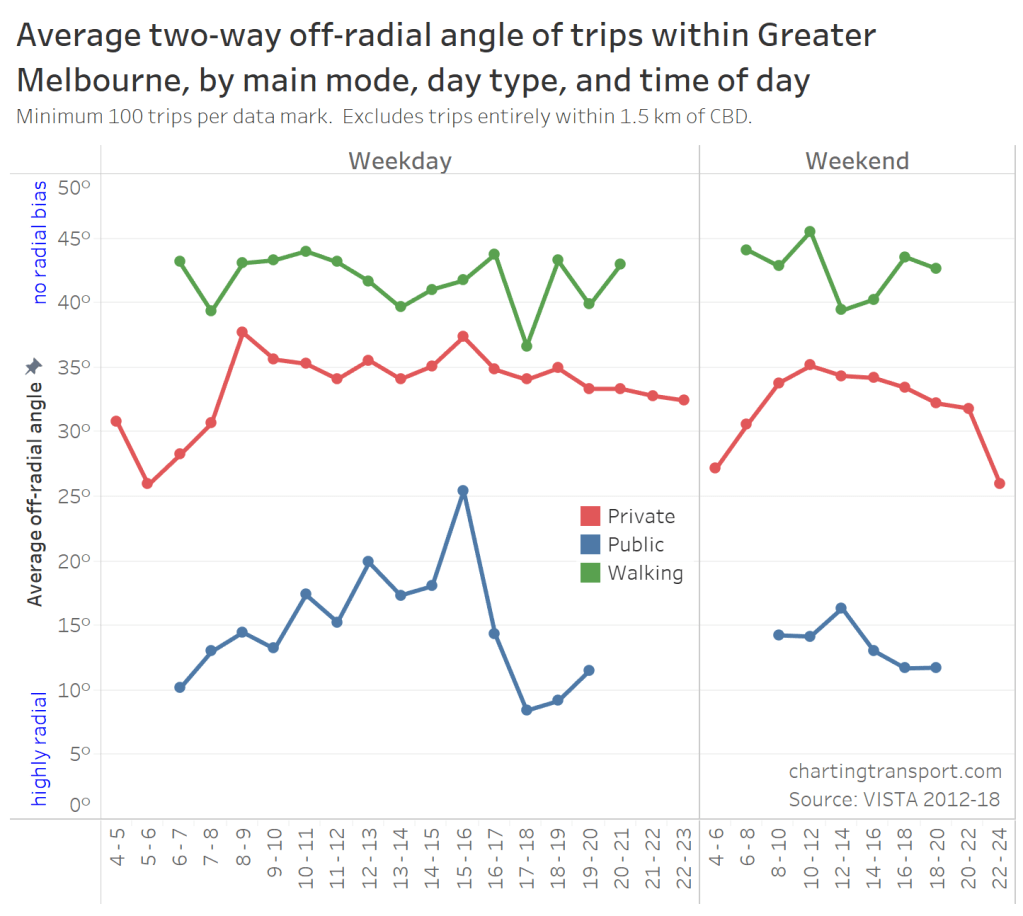
Technical notes: I’ve had to aggregate weekend data into two hour blocks to avoid issues with small sample sizes. I’m only showing data where there are at least 100 trips for a mode and time (that’s still not a huge sample size so there is some “noise”). Trips times are assigned by the clock hour of the middle of the trip duration. For example, a trip starting at 7:50 am and finishing at 9:30 am has a mid-trip time of 8:40 am and therefore is counted in 8 – 9 am for one hour intervals, and 8 – 10 am for two hour intervals.
You can see:
- Public transport trips are much more radial at all times of the week, but most particularly in the early AM peak and in the PM commuter peak. They are least radial in the period 3-4 pm on weekdays (PM school peak), which no doubt reflects school student travel, which is generally less radial.
- Private transport trips are more radial before 8 am on weekdays, and in the early morning and late evening on weekends. Curiously private transport trips in the PM peak don’t show up as particularly radial, possibly because there is more of a mix of commuter and other trips at that time.
- Walking trips show very little radial bias, except perhaps in the commuter peak times on weekdays.
When I drill down into specific modes, the sample sizes get smaller, so I have used 2 hour intervals on weekdays, and 3 hour intervals on weekends. Also to note is that VISTA assigns a “link mode” to each trip, being the most important mode used in the journey (generally train is highest, followed by tram, bus, vehicle driver, vehicle passenger, bicycle, walking only). I am using this “link mode” in the following charts.

Some observations:
- Train trips are the most radial, followed by tram trips (no surprise as these networks are highly radial).
- Bicycle trips are generally the third most radial mode, except at school times.
- Public bus trips are more radial in the commuter peak periods, and much less radial in the middle of the day on weekdays. The greater radialness in commuter peaks will likely reflect people using buses in non-rail corridors to travel to the city centre (particularly along the Eastern Freeway corridor). Most of Melbourne’s bus routes run across suburbs, rather than towards the city centre, which will likely explain bus-only trips being less radial than train and tram, particularly off-peak.
How does radialness vary by trip purpose and time of week?
The following chart shows the average two-way off-radial angle of trips by trip purpose (at destination) and time of day:

Some observations:
- Work related trips are generally the most radial, particularly in the AM peak (as you might expect), but less so on weekdays afternoons.
- Weekday education trips are the next most radial (excluding trips to go home in the afternoon and evening), except at school times (school travel being less radially biased than tertiary education travel).
- Social trips become much more radial late at night on weekends, probably reflecting inner city destinations.
- Recreational trips are the least radial on weekends.
- Otherwise most other trip purposes average around 35-40° – which is only slightly weighted towards radial travel.
What is the distribution of off-radial angles by time of day?
So far my analysis has been looking at radialness, without regard to whether trips are towards or away from the CBD. I’ve also used average off-radial angles which hides the underlying distribution of trip radialness.
I’m curious as to whether modes are dominated by inbound or outbound trips at any times of the week (particularly private transport), and the distribution of trips across various off-radial angles.
So to add the inbound/outbound component of radialness, I am going to use a slightly different measure, which I call the “one-way off-radial angle”. For this I am using a scale of 0° to 180°, with 0° being directly towards the CBD, and 180° being directly away from the CBD, and 90° being a perfectly orbital trip with regard to the CBD. For inbound trips, the one-way off-radial angle will be the same as the two-way off-radial angle, but outbound trips will instead fall in the 90° to 180° range.
One-way off-radial angles are still calculated relative to the trip end point (origin or destination) that is furthest from the CBD. I explained this in part 1.
Here is the distribution of one-way off-radial angles by time of day for trips where train was the main mode:

A reminder: only time intervals with a sample of at least 100 trips are shown.
In the morning, trips are very much inbound radial, with around three-quarters being angles of 0°-10°. Likewise in the PM peak, almost three-quarters of train trips are very outbound radial with angles 170°-180°.
As per the second chart in this post, train trips remain very radial throughout the day. But there is slightly more diversity in off-radial angles 3-4 pm on weekdays, when many school students use trains for journeys home from school that are less radially biased. Less radial trips could be a result of using two train lines, using bus in combination with train, or using a short section of the train network that isn’t as radial (eg Eltham to Greensborough, Williamstown to Newport, or a section of the Alamein line).
On weekends it’s interesting to see that there are many more inbound than outbound journeys between 12 pm and 2 pm on weekends. The “flip time” when outbound journeys outnumber inbound journeys is probably around 2 pm. This is consistent with CBD pedestrian counters that show peak activity in the early afternoon.
One problem with the chart above is that volumes of train travel vary considerably across the day. So here’s the same data, but as (estimated) average daily trips:
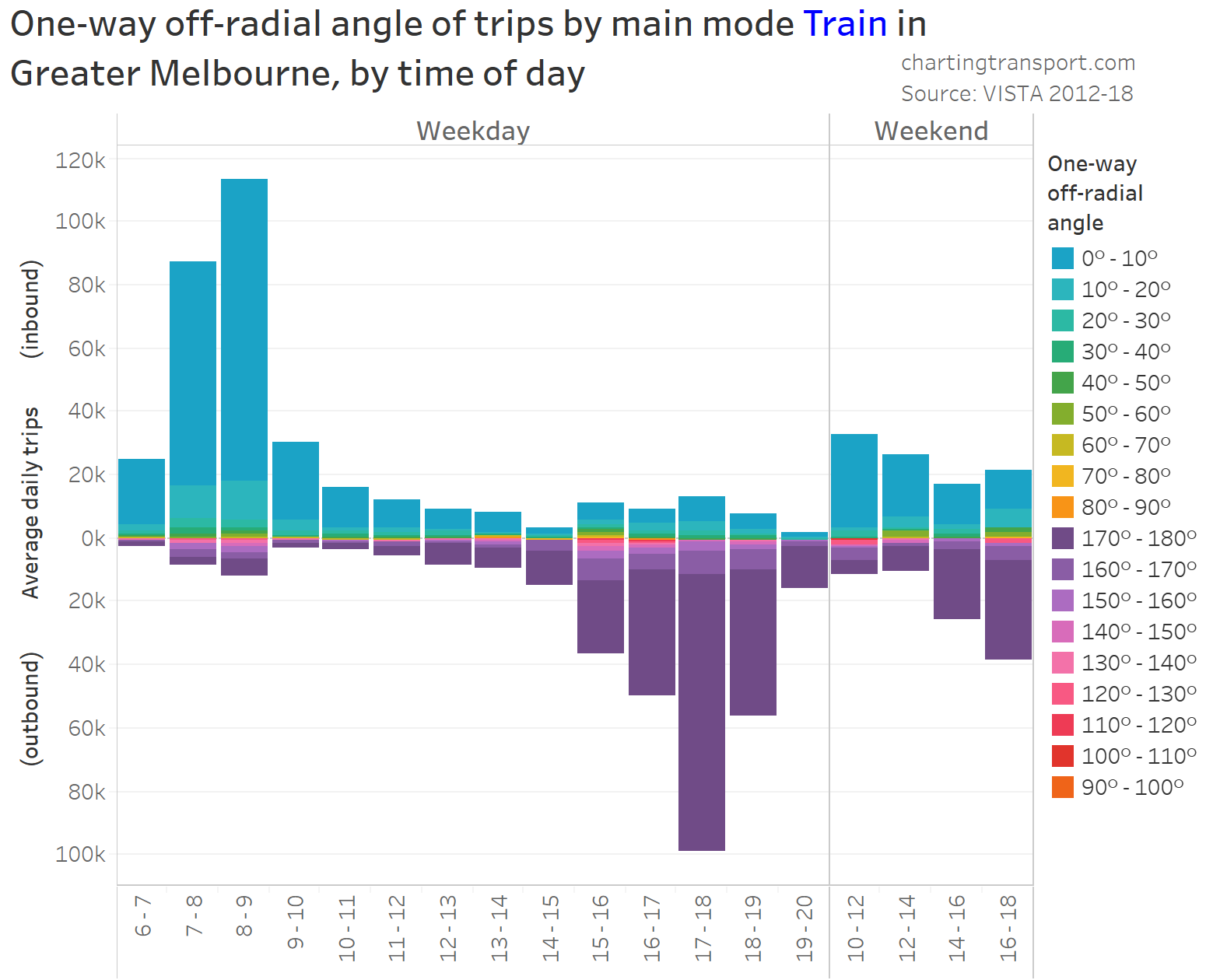
You can see the intense peak periods on weekdays, and a gradual switch from inbound trips to outbound trips around 1 pm on weekdays. There’s also a mini-peak in the “contra-peak” directions (outbound trips in the AM peak and inbound trips in the PM peak).
The weekend volumes are for two hour intervals so not directly comparable to weekdays (which are calculated for one hour intervals), but you can see higher volumes of inbound trips until around 2 pm, and then outbound trip volumes are higher.
Those results for trains were probably not surprising, but what about private vehicle driver trips?

There is much more diversity in off-radial angles at all times of the day, and a less severe change between inbound and outbound trips across the day.
On both weekday and weekend mornings there is a definite bias towards inbound travel. Afternoons and evenings are biased towards outbound travel, but not nearly as much (it’s much stronger late at night). This is consistent with the higher average two-way off-radial angle seen for private transport in the PM peak compared to the AM peak.
Here is the same data again but in volumes:

This shows the weekday AM peak spread concentrated between 8 and 9 am, while the PM peak is more spread over three hours (beginning with the end of school).
Here are the same two charts for tram trips (the survey sample is smaller, so we can only see results for weekdays):
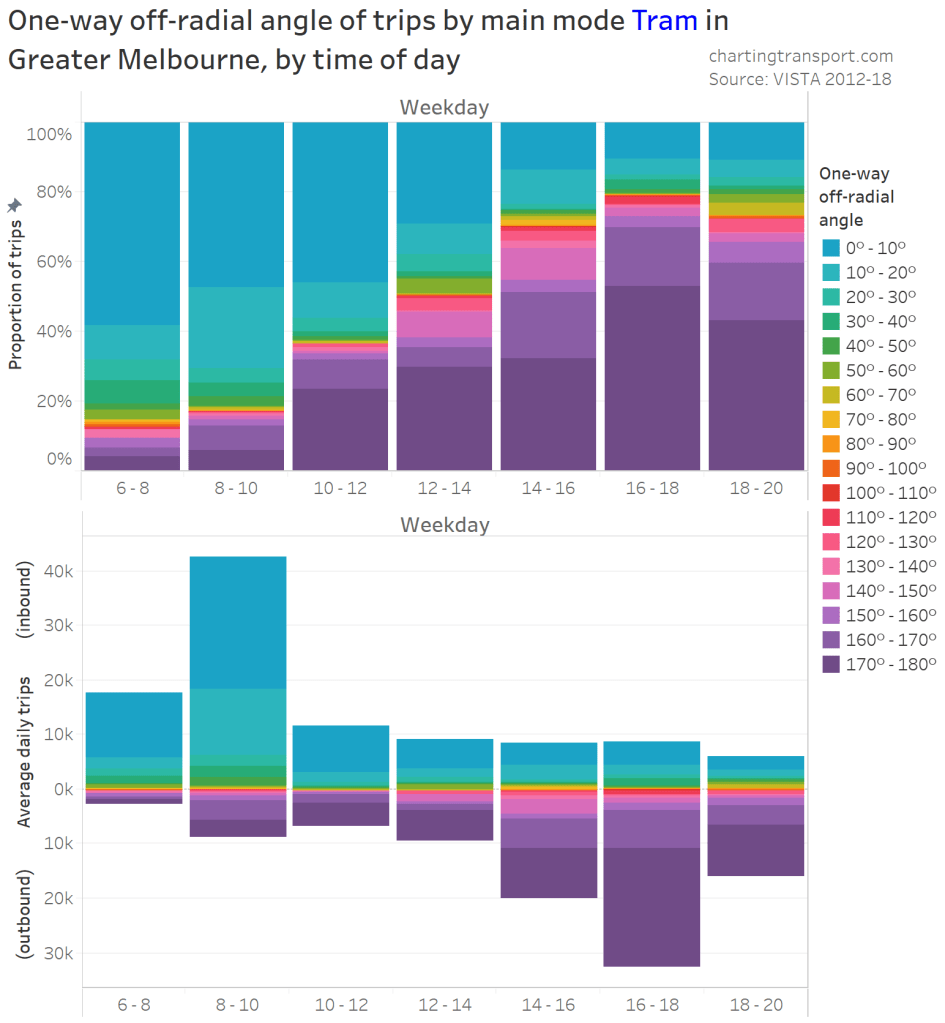
Again there is a strong bias to inbound trips in the morning and outbound in the afternoon, with slightly more diversity in the PM school peak, and early evening.
Next up public bus (a separate category to school buses, however many school students do travel on public buses):
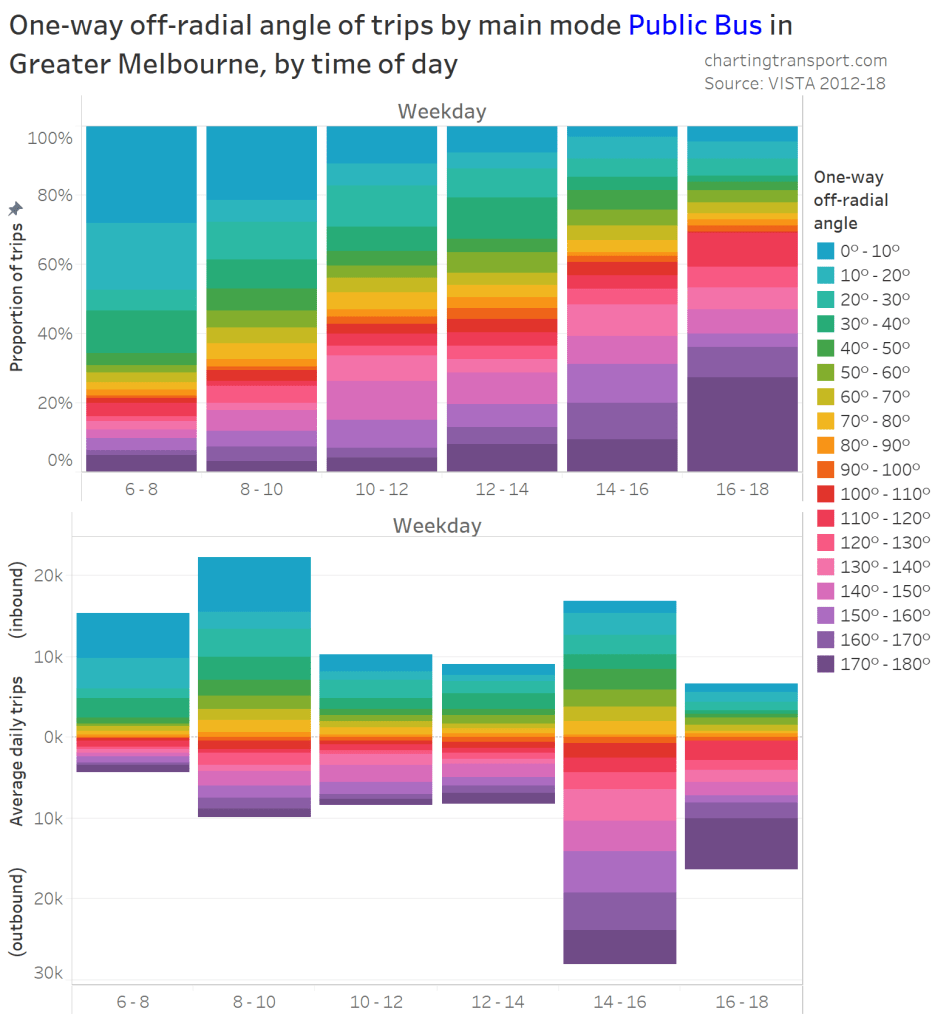
There is a lot more diversity in off-radial angles (particularly 2-4 pm covering the end of school), but also the same trend of more inbound trips in the morning and outbound trips in the afternoon.
Next up, bicycle:

There’s a fair amount of diversity, across the day, with inbound trips dominating the AM peak and outbound trips in the PM commuter peak (but not as strongly in the PM school peak). Weekend late afternoon trips show a little more diversity than morning and early afternoon trips, but the volumes are relatively small.
Next is walking trips:

There is considerable diversity in off-radial angles across most of the week, although outbound trips have a larger share in the late evening.
Walking volumes on weekdays peak at school times. On weekends walking seems to peak between 10 am and 12 pm and again 4 pm to 6 pm, but not considerably compared to the rest of the day time.
Mapping mode shares and radialness
So far I’ve been looking at radialness for modes by time of day. This section next section looks at radialness and mode shares by origins and destinations within Melbourne.
In recent posts I’ve had fun mapping journeys to work from census data (see: Mapping Melbourne’s journeys to work), so I’ve been keep to explore what’s possible for general travel.
VISTA is only a survey of travel (rather than a census), so if you want to map mode shares of trips around the city, you unfortunately need to lose a lot of geographic resolution to get reasonable sample sizes.
The following map shows private transport mode shares for journeys between SA3s (which are roughly the size of municipalities), where there were at least 80 surveyed trips (yes, that is a small sample size so confidence intervals are wider, but I’m also showing mode shares in 10% ranges). Dots indicate trips within an SA3, and lines indicate trips between SA3s. I’ve animated the map to make try to make it slightly easier to call out the high and low private mode shares.

You can see lower private transport mode shares for radial travel involving the central city (Melbourne City SA3), particularly from inner and middle suburbs (less so from outer suburbs). Radial travel that doesn’t go to the city centre generally has high private transport mode shares.
I also have origin and destination SA1s for surveyed trips. Here is a map showing all SA1-SA1 survey trip combinations by main mode, animated to show intervals of two-way off-radial angles:
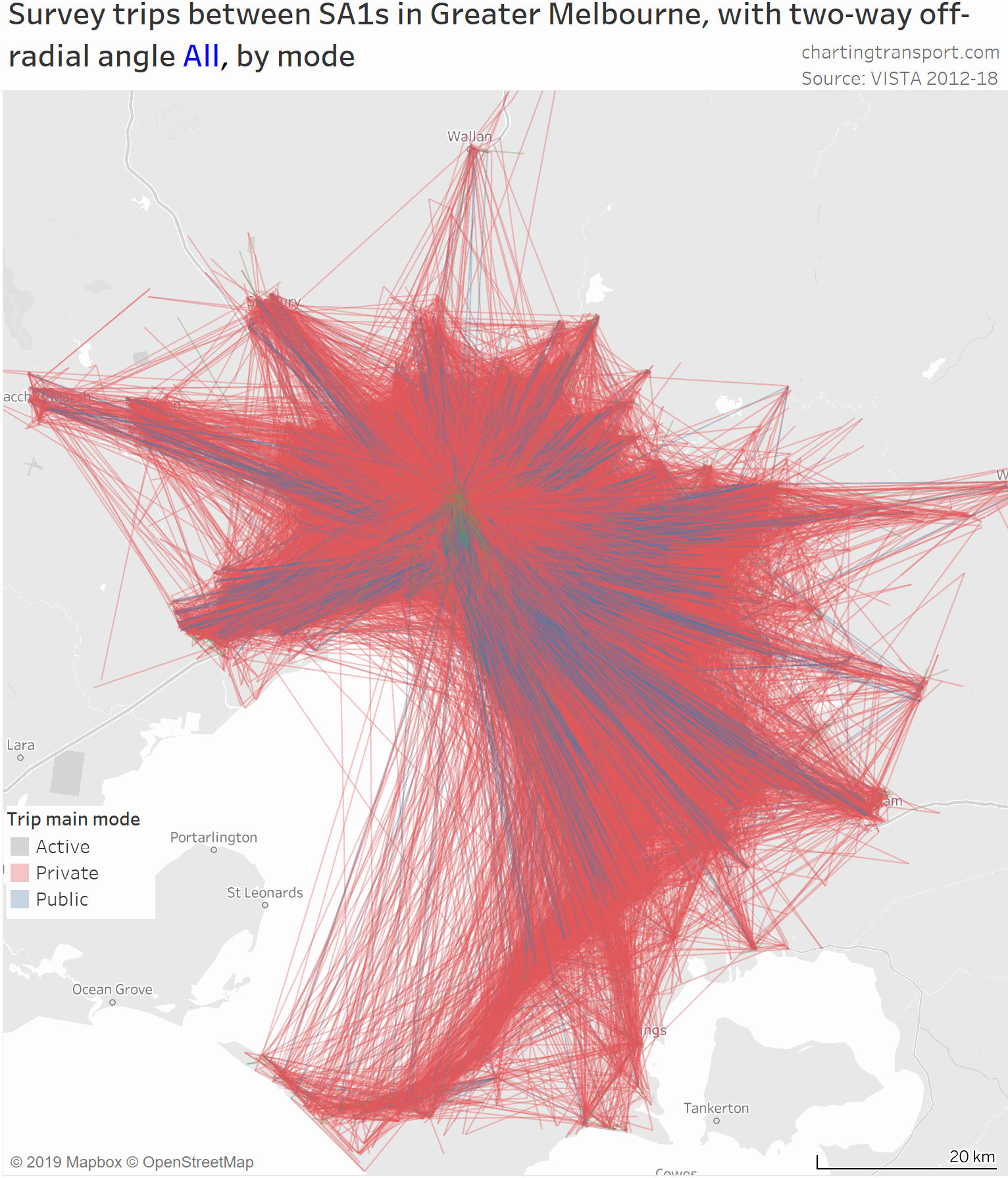
It’s certainly not a perfect representation because of the all the overlapping lines (I have used a high degree of transparency). You can generally see more blue lines (public transport) in the highly radial angles, and almost entirely red (private transport) and short green lines (active transport) for larger angle ranges. This is consistent with charts in my last post (see: How radial is general travel in Melbourne? (Part 1)).
You can also see that few trips fall into the 80-90° interval, which is because I’m measuring radialness relative to the trip endpoint furthest from the CBD. An angle of 80-90° requires the origin and destination to be about the same distance from the CBD and for the trip to be relatively short.
So there you go, almost certainly more than you ever wanted or needed to know about the radialness of travel in Melbourne. I suspect many of the patterns would also be found in other cities, although some aspects – such the as the geography of Port Phillip Bay – will be unique to Melbourne.
Again, I want to the thank the Department of Transport for sharing the full VISTA data set with me to enable this analysis.
